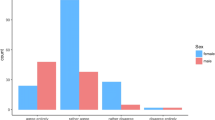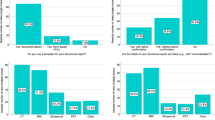Abstract
Objectives
The aim of this study is to present the results of the Italian survey on teleradiology (TR).
Methods
Two radiologists created an online electronic survey using the Survey Monkey web-based tool. The questionnaire was then improved by suggestions from a multidisciplinary group of experts. In its final form, the survey consisted of 19 multiple-choice questions. Space was left below each question for participants to add their personal comments. Members of Italian Society of Medical Radiology (SIRM) were given 2 weeks to perform the survey.
Results
A total of 1599 radiologists, corresponding to 17 % of all SIRM radiologists, participated into the online survey. As a result, 62 % of participants have a positive opinion on teleradiology, while 80 % including 18 % with a negative opinion believe that teleradiology will have a future. 55 % of responders (n = 874) use teleradiology in their clinical practice. The majority of users adopt intra-mural teleradiology for coverage of emergencies (47 %), of night and weekend shifts (37 %) or to even out distribution workload (33 %). Most responders still show concern on the use of teleradiology. In particular, they think that teleradiology is too impersonal (40 %), and that it is responsible for insufficient communication with the referring clinician (39 %).
Conclusions
The majority of Italian radiologists are favorable to teleradiology. However, they have concerns that teleradiology may further reduce communication with the referring clinician ad patient.
Similar content being viewed by others
References
European Society of Radiology (ESR) (2014) ESR white paper on teleradiology: an update from the teleradiology subgroup. Insights Imaging 5:1–8
Ranschaert ER, Barneveld Binkhuysen FHB (2012) European teleradiology now and in the future: results of an online survey. Insights Imaging 4:93–102
Deloitte and Ipsos Belgium (2011) eHealth Benchmarking III SMART 2009/0022 Final Report. 1–274. http://ec.europa.eu/information_society/eeurope/i2010/docs/benchmarking/ehealth_benchmarking_3_final_report.pdf. Accessed 23 Jan 2012
Ross P, Sepper R, Pohjonen H (2010) Cross-border teleradiology—experience from two international teleradiology projects. Eur J Radiol 73:20–25
Benjamin M, Aradi Y, Shreiber R (2010) From shared data to sharing workflow: merging PACS and teleradiology. Eur J Radiol 73:3–9
European Society of Radiology 2009 (2010) The future role of radiology in healthcare. Insights Imaging 1:2–11
Dixon AK, FitzGerald R (2008) Outsourcing and teleradiology: potential benefits, risks and solutions from a UK/European perspective. J Am Coll Radiol 5:12–18
Rapporti ISTISAN, Roma, October–December 2010
Rylands-Monk F (2011) France acts on teleradiology to ensure ethics and quality. http://www.auntminnieeurope.com/index.aspx?sec=sup&sub=ris&pag=dis&ItemID=605119. Accessed 14 July 2013
Survey Monkey web-based survey tool. https://www.surveymonkey.com. Accessed June 2014
http://help.surveymonkey.com/articles/en_US/kb/How-to-analyze-results
Rosenberg C, Langner S, Rosenberg B, Hosten N (2011) Medizinische und rechtliche Aspekte der Teleradiologie in Deutschland. Rofo 183:804–811
Levin DC, Rao VM (2011) Outsourcing to teleradiology companies: bad for radiology, bad for radiologists. J Am Coll Radiol 8:104–108
Ross P (2011, September) Pros and cons of international teleradiology services. Presentation held at MIR annual scientific meeting, Nice
Barneveld Binkhuysen FH, Ranschaert ER (2011) Teleradiology: evolution and concepts. Eur J Radiol 78:205–209
Lienemann B, Hodler J, Luetolf M, Pfirrmann CWA (2005) Swiss teleradiology survey: present situation and future trends. Eur Radiol 15:2157–2162
Silva E, Breslau J, Barr RM, Liebscher LA et al (2013) ACR white paper on teleradiology practice: a report from the task force on teleradiology practice. J Am Coll Radiol 10(8):575–585
Investing in the clinical radiology workforce—the quality and efficiency case March 2012; Royal College of Radiologists
Marlia: sentenza e percorso; http://www.radiologiamedica.org
Ranschaert ER, Boland GW, Duerinckx AJ, Barneveld Binkhuysen FH (2015) Comparison of European (ESR) and American (ACR) white papers on teleradiology: patient primacy is paramount. J Am Coll Radiol. 12(2):174–182
Directive 2011/24/EU of the European Parliament and of the Council of 9 March 2011 on the application of patients’ rights in cross-border healthcare (2011). OJL 88:45–65
The Royal College of Radiologists (2012) The regulation of teleradiology. A position statement by the Royal College of Radiologists. The Royal College of Radiologists, London
The Royal College of Radiologists (2012) Standards for the communication of critical, urgent and unexpected significant radiological findings, 2nd edn. The Royal College of Radiologists, London
The Royal College of Radiologists (2011) Standards and recommendations for the reporting and interpretation of imaging investigations by non-radiologist medically qualified practitioners and teleradiologists. The Royal College of Radiologists, London
Author information
Authors and Affiliations
Corresponding author
Ethics declarations
Conflict of interest
The authors do not have any competing interest to be disclosed.
Ethical approval
This article does not contain any studies with human participants performed by any of the authors.
Appendix
Appendix
Appendix shows all 19 questions with answers of the survey
1. In which region do you work? | |
|---|---|
Abruzzo | 1.89 % |
Basilicata | 0.50 % |
Calabria | 3.09 % |
Campania | 6.80 % |
Emilia Romagna | 9.76 % |
Friuli Venezia Giulia | 2.02 % |
Lazio | 12.47 % |
Liguria | 3.90 % |
Lombardia | 15.99 % |
Marche | 2.77 % |
Molise | 0.38 % |
Piemonte | 5.73 % |
Puglia | 6.49 % |
Sardegna | 1.89 % |
Sicilia | 7.43 % |
Toscana | 8.82 % |
Trentino Alto Adige | 1.51 % |
Umbria | 1.57 % |
Valle d’Aosta | 0.44 % |
Veneto | 6.55 % |
2. What age group do you belong in? | |
|---|---|
25–35 years old | 16.96 % |
36–45 years old | 22.09 % |
46–55 years old | 25.76 % |
56–65 years old | 30.82 % |
Over 65 | 4.37 % |
3. What is the site of your main professional activity? | |
|---|---|
Public hospital | 64.35 % |
Private hospital | 10.19 % |
University hospital | 12.06 % |
Research institute | 2.26 % |
Private diagnostic centre | 11.15 % |
4. What is your professional degree? | |
|---|---|
Radiology resident | 7.95 % |
Consultant radiologist self employed (libero professionista) | 15.70 % |
Radiologist with fixed term managerial position (incarico dirigenziale a tempo determinato) | 6.16 % |
Radiologist with basic managerial position (incarico dirigenziale di natura professionale di base) | 28.87 % |
Radiologist with managerial position with high specialization (incarico dirigenziale di natura professionale elevate) | 13.05 % |
Radiologist director of simple unit (incarico di direzione di struttura semplice) | 11.72 % |
Radiologist director of complex unit (incarico di direzione di struttura complessa) | 13.51 % |
University researcher | 0.86 % |
Professor associate (professore associato) | 0.99 % |
Professor (professore ordinario) | 1.19 % |
5. Do you use digital signature in your Institute? | |
|---|---|
Yes | 65.38 % |
No | 32.02 % |
Occasionally | 2.60 % |
6. How are radiological images stored in your Institute? | |
|---|---|
On a analog archive | 5.73 % |
Each diagnostic modality has its own archive | 5.02 % |
On a PACS system | 17.64 % |
On PACS of the Department | 48.16 % |
On PACS of 2 or more health facilities | 23.05 % |
On PACS; Images and clinical data are accessible from electronic health records | 8.11 % |
7. Where do you usually use Teleradiology? | |
|---|---|
I don’t use teleradiology (if you answer yes go directly to question 15) | 45.26 % |
Within hospital on a dedicated workstation | 47.52 % |
At home | 8.83 % |
Everywhere using a mobile | 5.93 % |
8. Which application do you use for Teleradiology? | |
|---|---|
Same application utilized for other radiological activities | 87.40 % |
‘Stand alone’ application only for teleradiological activities | 8.21 % |
‘Add on’ application of reporting system with specific added functions | 4.39 % |
9. What are the reasons of the use of teleradiology? (Table 2) | |
|---|---|
For reporting of examinations performed in the company where I work (remote management procedures of intra-company deferrable urgent/emergency) | 47.32 % |
For reporting of examinations performed in the facility where I work (remote management procedures intra hospital) | 33.26 % |
As part of regular workflow in the institute where I work (outsourcing) | 12.28 % |
For a second or expert opinion from a colleague with another sub-specialty | 21.65 % |
For a second opinion from a colleague with a different specialty (for example a neurosurgeon) | 15.96 % |
For online multidisciplinary meetings | 4.91 % |
On a temporary basis (staff shortages, holidays and illness) | 6.70 % |
For night and week-end coverage | 37.28 % |
For double reading (for example mammography) | 7.03 % |
For research or teaching purposes | 5.25 % |
Other | 8.82 % |
10. What are the disciplines for which is required a second opinion in your Institute? | |
|---|---|
We receive second opinion requests for every kind of examination | 24.37 % |
Neuroradiological consults | 17.05 % |
For pediatric examinations | 4.23 % |
For evaluation of interventional procedures | 13.04 % |
In out Institute we do not receive second opinion requests | 48.74 % |
Other | 6.52 % |
11. What are the disciplines for which do you usually ask a second opinion? | |
|---|---|
We ask a second opinion for every kind of examination if particulary complicated | 17.94 % |
For neuroradiological examination | 30.21 % |
For pediatric examination | 4.63 % |
For evaluation of interventional procedures | 7.99 % |
We don’t ask second opinions to other Institute | 51.39 % |
12. How do you usually receive patient’s clinical informations? | |
|---|---|
By telephone | 26.78 % |
By fax | 7.82 % |
By e mail | 4.37 % |
By instant messaging software (ex. Viber, Whatsapp) | 1.03 % |
By direct connection with RIS | 52.64 % |
Utilizing a dedicated platforms | 7.36 % |
13. How do you usually send the examination’s report? | |
|---|---|
By telephone | 4.30 % |
By fax | 5.58 % |
By e mail | 6.28 % |
By instant messaging software (ex. Viber, Whatsapp) | 0.58 % |
By direct connection with RIS | 74.77 % |
Utilizing a dedicated platforms | 8.49 % |
18. In conclusion do you think that teleradiology could be an advantage or a disadvantage for radiologist? | |
|---|---|
Yes, I am enthusiastic, I think that teleradiology could be an advantage for radiologist | 10.03 % |
Yes, I am generally favorable | 51.86 % |
No, I am generally unfavorable | 18.31 % |
No, I am absolutely unfavorable, I think that teleradiology is a disadvantage for radiologist | 11.53 % |
I don’t know, I am not convinced | 8.27 % |
19. Do you think that teleradiology could have a future? | |
|---|---|
Absolutely not | 2.08 % |
No | 3.89 % |
I don’t know | 14.01 % |
Yes | 58.63 % |
Absolutely yes | 21.40 % |
Rights and permissions
About this article
Cite this article
Coppola, F., Bibbolino, C., Grassi, R. et al. Results of an Italian survey on teleradiology. Radiol med 121, 652–659 (2016). https://doi.org/10.1007/s11547-016-0640-7
Received:
Accepted:
Published:
Issue Date:
DOI: https://doi.org/10.1007/s11547-016-0640-7




